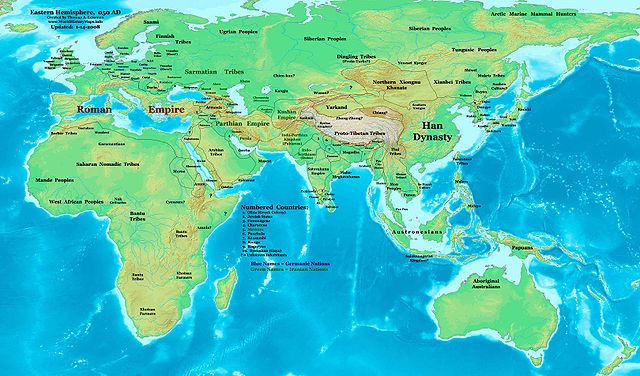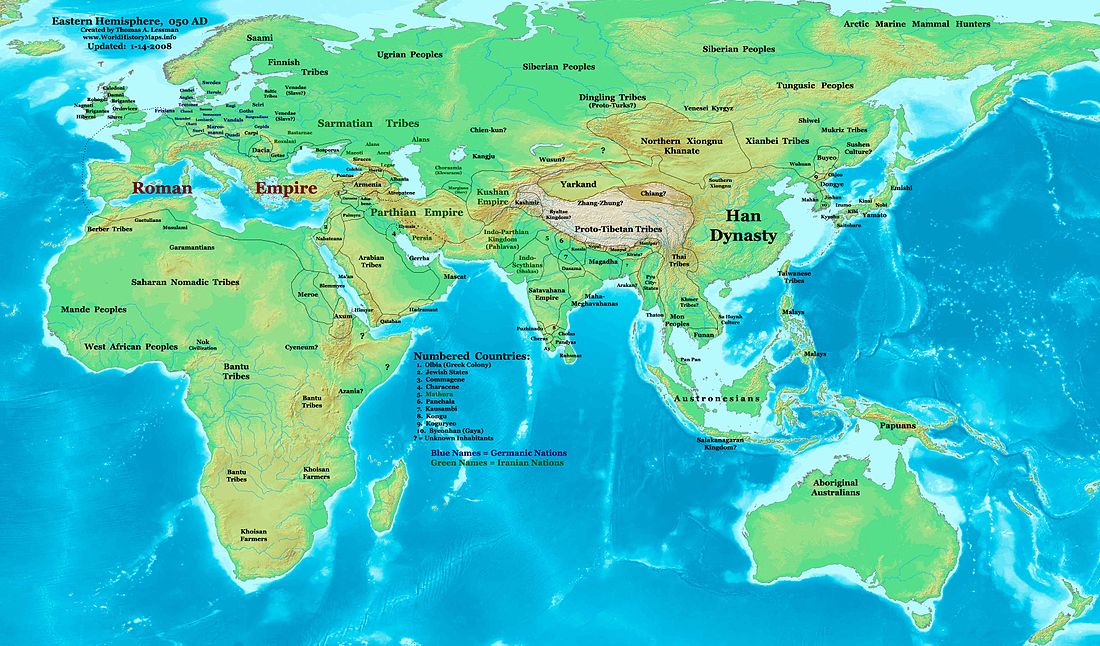Top Qs
Timeline
Chat
Perspective
50s
Sixth decade of the first century AD From Wikipedia, the free encyclopedia
Remove ads
The 50s decade ran from January 1, 50, to December 31, 59. It was the sixth decade in the Anno Domini/Common Era, if the nine-year period from 1 AD to 9 AD is considered as a "decade".
This article needs additional citations for verification. (February 2016) |

The early years of the decade saw Roman and Parthian intervention in the Iberian–Armenian War, a conflict which led Tiridates I to become King of Armenia with Parthian support. This was unacceptable to Rome, and the ensuing tensions culminated in the Roman–Parthian War of 58–63. Concurrently, the Roman conquest of Britain continued, with Caratacus being defeated in 50 and tribes of modern Wales being subdued in 58 to 59. In 50, the Southern Xiongnu submitted to the Chinese Han dynasty. Later in 57, the ascension of Emperor Ming heralded the beginning of a golden age.
The Council of Jerusalem was held early in the decade: The council decided that Gentile converts to Christianity were not obligated to keep most of the fasts, and other specific rituals, including the rules concerning circumcision of males.[1] The Council did, however, retain the prohibitions on eating blood, meat containing blood, and meat of animals that were strangled, and on fornication and idolatry.
Literary works of this decade include De Vita Beata (which explains that the pursuit of happiness is the pursuit of reason) and De Clementia (an instructional contrast between the good ruler and a tyrant), both of which were written by Seneca the Younger.
Manning (2008) tentatively estimates the world population in AD 50 as 248 million.
Remove ads
AD 50
By place
Roman Empire
- Cologne is raised to the status of a city.
- Utrecht is founded, and a Roman fortification (castellum) is constructed at the Rhine border in the present-day Netherlands.
- Claudius adopts Nero.
- In Judaea, a Roman soldier seizes and burns a Torah scroll. Procurator Cumanus has the culprit beheaded, calming down the Jews and delaying for almost two decades the outbreak of their revolt.[2]
- In Britain, governor Publius Ostorius Scapula begins his campaign against the recalcitrant Silures of south Wales, who are led by the former Catuvellaunian prince Caratacus. London (Londinium), Exeter (Isca Dumnoniorum), Tripontium (near modern Rugby) and the fort of Manduessedum (near modern Atherstone) are founded (approximate date).
- Roman emperor Claudius appoints Agrippa II governor of Chalcis.
- Romans build a wooden bridge across the Thames in the London area.
South Asia
- The Yuezhi tribes are united under the Kushan leader Kujula Kadphises, thus creating the Kushan Empire in Afghanistan and northern India. (approximate date
Americas
- The San Bartolo pyramid is completed around this time.
By topic
Religion
- Paul travels to Philippi, Thessaloniki, Veroia, and Athens (second missionary journey).
- Christianity is introduced throughout Nubia by a high official of Queen Judith.
- The Epistle to the Romans is written (approximate date).
- The Apostles hold the Council of Jerusalem (approximate date).
Arts and sciences
- Hero of Alexandria invents a steam turbine (possible date).
- Pamphilus of Alexandria writes a poetic lexicon.
- Pedanius Dioscorides describes the medical applications of plants in De Materia Medica.
- Diogenes, the Greek explorer, discovers the African Great Lakes.
- The distinction between chronic maladies and acute illnesses is made by Thessalos.
Remove ads
Demographics
Due to lack of reliable demographic data, estimates of the world population in the 1st century vary wildly, with estimates for AD 1 varying from 150[14] to 300[15] million. Demographers typically do not attempt to estimate most specific years in antiquity, instead giving approximate numbers for round years such as AD 1 or AD 200. However, attempts at reconstructing the world population in more specific years have been made, with Manning (2008) tentatively estimating the world population in AD 50 as 248 million.[16]
Remove ads
Significant people
Births
AD 50
- Cai Lun, Chinese inventor of paper and the papermaking process (d. 121)
AD 53
- (approximate year) Marcus Ulpius Traianus, Roman emperor (d. 117)[17]
- Domitia Longina, Roman empress (approximate date)
- Kanishka I, Indian ruler of the Kushan Empire (d. 150)
AD 55
- Epictetus, Greek-Roman philosopher (d. 135)[18]
AD 56
- Gaius Cornelius Tacitus, Roman historian.[19]
AD 57
- Han Zhang Di, Chinese emperor (d. AD 88)
AD 58
- Juvenal, Roman poet and writer (approximate date)
- Xu Shen, Chinese politician and writer (approximate date)
Remove ads
Deaths
AD 50
- Abgar V, Roman client king of Osroene (approximate date)
- Aulus Cornelius Celsus, Roman author of De Medicina (b. c. 25 BC)
- Gamaliel the Elder, Jewish ruler (Nasi) in Babylonia (approximate date)
- Gaius Julius Phaedrus, Roman fabulist (b. c. 15 BC)
- Philo of Alexandria, Jewish philosopher (b. c. 20 BC)
- Scribonius Largus, Roman court physician (b. c. AD 1)
AD 51
- Gotarzes II, king of the Parthian Empire
- Lucius Vitellius the Elder, Roman consul (b. 5 BC)
- Mithridates of Armenia, Roman client king
- Vonones II, king of the Parthian Empire
AD 52
- Gamaliel, Jewish leader (nasi) (approximate date)
- Guo Shengtong, Chinese empress of the Han Dynasty
- Julia Iotapa, queen of Commagene (approximate date)
- Publius Ostorius Scapula, Roman statesman and general
AD 53
AD 54
- October 13 – Claudius, Roman emperor, possibly poisoned by his wife Agrippina (b. 10 BC)[6]
- Ban Biao, Chinese historian and official (b. AD 3)[20]
- Domitia Lepida the Younger, widow of Marcus Valerius Messalla Barbatus, mother of Valeria Messalina and former mother-in-law of Claudius (b. 10 BC)
- Gaius Stertinius Xenophon, Greek physician, possibly poisoned Claudius
- Marcus Junius Silanus, Roman consul (b. AD 14)
- Stachys the Apostle, Byzantine bishop and saint
AD 55
- February 11 – Britannicus, son of Claudius (b. AD 41)
- Antonia Tryphaena, Roman client queen (b. 10 BC)
- Izates bar Monobaz, Parthian client king (b. c. AD 1)[21]
AD 56
- Lucius Volusius Saturninus, Roman politician and governor[22]
AD 57
- March 29 – Guang Wu, Chinese emperor (b. 5 BC)[23]
- Quintus Veranius, Roman consul and general
- Yuri, Korean ruler of Silla[11]
AD 58
- Deng Yu, Chinese general of the Han dynasty (b. AD 2)
- Geng Yan, Chinese general of the Han dynasty (b. AD 3)
- Pharasmanes I, Roman client king of Iberia
- Rhadamistus, Roman client king of Armenia
AD 59
- March 23 – Agrippina the Younger, mother of Nero (b. AD 15)
- Domitia Lepida the Elder, granddaughter of Mark Antony
- Gnaeus Domitius Afer, Roman politician and orator
- Servilius Nonianus, Roman consul and historian
Remove ads
References
Wikiwand - on
Seamless Wikipedia browsing. On steroids.
Remove ads
